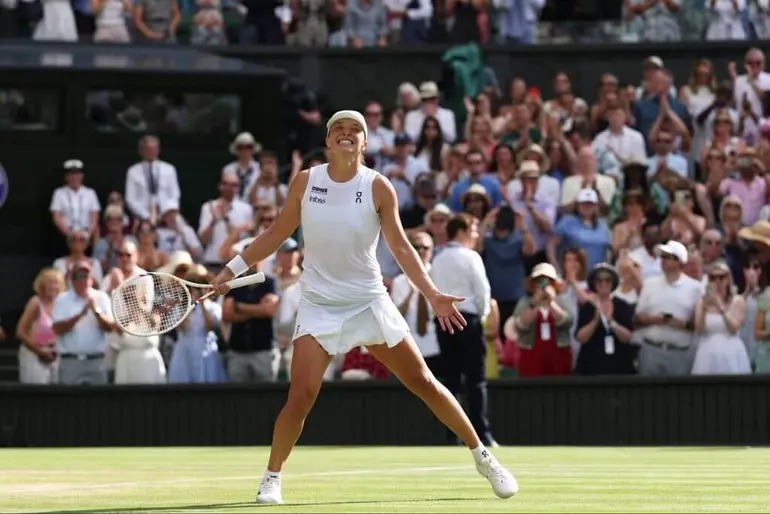THE ALL ENGLAND CLUB, LONDON — Iga Świątek’s Historic 6‑0, 6‑0 Wimbledon Triumph
Iga Świątek’s 6‑0, 6‑0 Wimbledon final over Amanda Anisimova marks her first grass major and a rare double bagel—discover tactics, records & future impact.
A Clinched Finish Under Centre Court Lights
It was just 57 electrifying minutes at the All England Club—but what a statement. In a display of dominance few have ever witnessed, Iga Świątek annihilated Amanda Anisimova 6‑0, 6‑0 in the Wimbledon women’s final. This isn’t simply a stat to add to her résumé—it’s her first Wimbledon title and sixth Grand Slam triumph, stamped with the rare and historic double bagel mark. In this post, we’ll dissect the final’s nerve-wracking tension, Świątek’s tactical brilliance, her place among the all-time greats, and what this means for the future of women’s tennis.
What Makes a Double Bagel So Extraordinary?
- Just the third time in Open Era Grand Slam finals history—and the first since Steffi Graf’s 6‑0, 6‑0 win at the 1988 French Open (Wikipedia, Live India).
- The last Wimbledon women’s final ending in a bagel was in 1911 (Wall Street Journal).
- Djokovic once joked it’s “merciless tennis”—but even legends cry when nerves take over.
Grand Slam Nerves: When the World Watches
Anisimova—only 23—felt the weight of the occasion immediately. Though confident after stunning world No. 1 Sabalenka, nerves set in under Centre Court’s bright lights and the royal audience (Wall Street Journal).
First-Serve Anxiety
- Her first-serve percentage collapsed to 33%, compared to Świątek’s impressive 80% (The Independent).
- She netted 3 double faults, while Świątek totaled just 2 (The Independent).
Unforced Errors & Mental Pressure
- Anisimova committed 28 unforced errors vs. Świątek’s 11, including 14 in the first set alone (Wikipedia).
- “I was frozen with nerves,” she admitted post-match, noting fatigue from the long fortnight (Outlook India).
Świątek’s Tactical Masterclass: Exploiting the Backhand
Świątek executed a precise strategy: target the American’s feared backhand to force mistakes and open the court.
- Inside‑out backhands kept Anisimova stretching, opening up short balls for Świątek’s power shots.
- She wasn’t afraid: attacking Anisimova’s strength signaled dominance and tactical clarity (The Federal).
- The result? Just 10 winners for Świątek but 55 total points to Anisimova’s 24 (ESPN.com).
By the Numbers: A Statistical One‑Sidedness
| Stat | Świątek | Anisimova |
|---|---|---|
| First-serve % | 78–82% | 33–45% |
| Break points saved/created | 0/6 | 33% saved |
| Total points won | 55 | 24 |
| Aces vs double faults | 3 / 2 | 0 / 5 |
| Winners | 10 | 8 |
| Unforced errors | 11 | 28 |
These numbers illustrate not just dominance, but strategic precision—Świątek broke serve six times, all while maintaining consistent pressure (Wikipedia).
Legacy Secured – Świątek Among the Immortals
- With this victory, Świątek becomes one of only eight women to win all four major titles in the Open Era, and currently the only active player to boast Slam titles on clay, hard, and grass (ESPN.com).
- She improves to a 6–0 record in major finals, tying her with Monica Seles and trailing only Venus Williams (7Slams) (ESPN).
- At only 24, she joins legends like Court, Seles, Graf, Hingis, Sharapova, and Barty by winning her first six Slam finals (Wikipedia).
Świątek’s triumph is not just big—it cements her place among the all-time greats.
Format Debate: Does Women’s Tennis Need 5‑Set Finals?
The best‑of‑three format heightened the drama—but also sparked controversy.
- Matches like this can end in under an hour, leaving little room to recover from a bad start.
- Advocates for best‑of‑five argue it allows poor starts to be overcome, as seen in Alcaraz’s 2023 men’s final (Talksport).
- Even pundits wonder: is this fair?
Whether it changes or not, the debate is intensified by matches like this.
Inside the Winners’ Circle: Post‑Match Reactions
Świątek’s Reflection
“I didn’t even dream of this… I feel like I am already an experienced player… but I never expected to win this one.”
She credited her team’s belief in her more than her own (The Independent).
Anisimova’s Grace
“I wish I could have put on a better performance… My mom’s put in more work than I have, honestly.”
Emotional yet composed, she promised to learn and return stronger (The Independent).
Inside the mixed emotions lay a testament to both athletes’ value in the players’ symphony.
What’s Next – Winning, Losing & Lessons
For Świątek:
- Moves back to World No. 1/Top 3 ranking, depending on points (Wall Street Journal).
- Now eyes the Australian Open to complete the Career Grand Slam.
For Anisimova:
- Gains invaluable first-time Grand Slam experience—and despite the final, her run included a stunning upset over Sabalenka (Talksport).
- With mental resilience as her next target, she remains a talent to watch.
Strong Conclusion: A Moment Etched in Wimbledon Lore
When Iga Świątek walked off Centre Court, Venus Rosewater Dish in hand, she wasn’t just a champion—she was a force of nature. This emphatic 6‑0, 6‑0 win isn’t just another Slam; it’s a career-defining moment that proves she can dominate on any surface under any conditions.
As the tennis world recalibrates, two questions emerge:
- Can anyone challenge Świątek on grass moving forward?
- How will Anisimova bounce back from this tough finale?
Loved this deep dive? Like, share, and subscribe to stay ahead with written & video content analyzing all Grand Slams, from strategy breakdowns to format debates, and the next generation of tennis royalty.
Internal Links
- Inside Świątek’s clay‑court reign at Roland-Garros
- Explained: Why women’s tennis may need best‑of‑five finals
External Authority Sources
- “1988 French Open – Women’s singles” (Wikipedia overview) (sportsmole.co.uk, The Tribune, Wikipedia, Tennis Majors)
- ESPN recap of the final with stats
